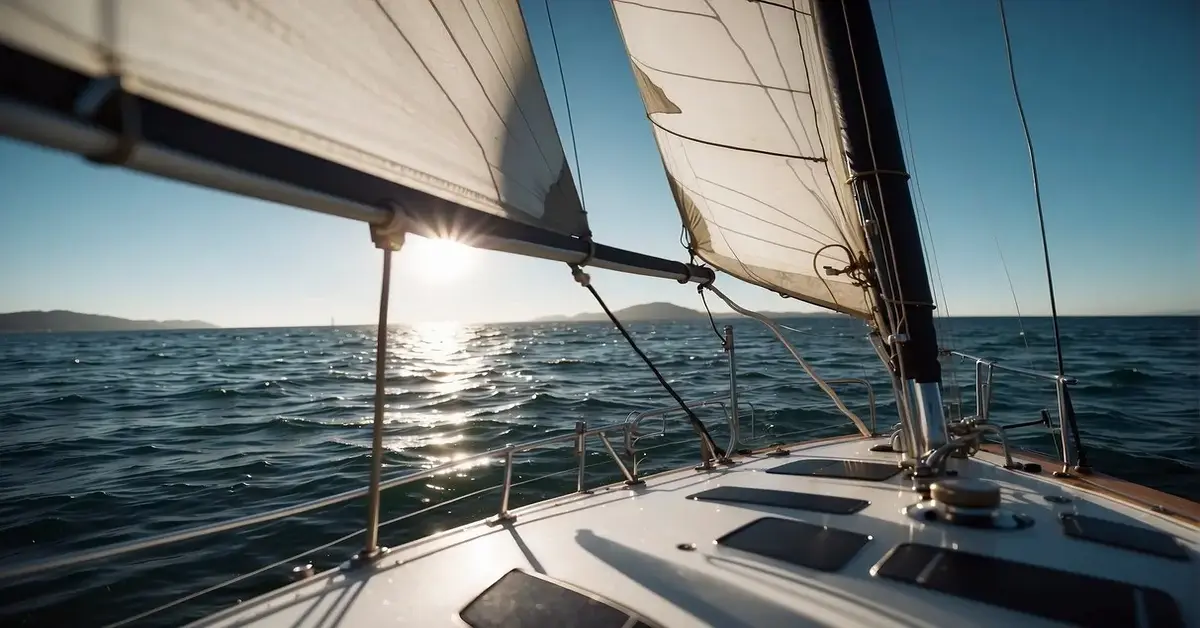Master the art of “Sailing Downwind” with this comprehensive guide. Downwind sailing presents a unique challenge; it’s about harmony with the wind, leveraging its power to glide across the water effortlessly. Unlike upwind sailing, where you combat the wind’s force, downwind sailing requires you to embrace and ride the breeze, making it both thrilling and complex.
Many enthusiasts find downwind sailing tricky, as it involves a delicate balance between the true and apparent wind—the wind you feel while in motion. This guide is designed to demystify these concepts and offer step-by-step instructions for refining your downwind technique, ensuring you find that perfect angle where your sails fill without creating excessive drag.
Whether you’re a seasoned sailor or a beginner, this guide will equip you with the knowledge to elevate your downwind sailing experience, turning every journey into an exhilarating adventure.
I conquer the waves as I master sailing downwind, harnessing the breeze for pure exhilaration.
How to Sailing Downwind – My Top 5 Steps You Need to Know
When I first started sailing, mastering how to sail downwind was thrilling and daunting. But with these top 5 steps, you’ll find it’s a breeze to get the hang of it.
- Set Your Sails
To effectively sail downwind, ensure your sails are correctly adjusted. I usually start by easing the mainsail and the jib to catch the wind from behind. If you have a spinnaker, deploying it can significantly boost speed. - Stabilize Your Course Keep a steady course and avoid dangerous accidental jibes. I recommend using a boom preventer to prevent it from swinging erratically, which is both a safety measure and aids in maintaining a consistent sailing angle.
- Use the Right Equipment If you’re using a symmetric spinnaker, setting up a spinnaker pole helps maintain the optimal angle of the sail. Learn from downwind sailing experts who show how to rig and stabilize the pole for a smooth ride.
- Monitor Wind and Waves I always monitor the wind direction and wave patterns, making small adjustments to the rudder and sails as needed. Responding promptly to changes prevents the boat from being caught off-balance.
- Practice Safety Maneuvers Before heading out, I practice maneuvers like jibing in controlled conditions. Staying alert and prepared helps ensure downwind sailing is safe and enjoyable.
By following these steps, downwind sailing will soon feel like second nature. Enjoy the ride and the unique sense of freedom that comes with it!
Understanding Downwind Sailing

When I set out to master how to sail downwind, I learned that the real magic happens when wind and sail work together. Let me guide you through the core elements for a smooth downwind journey.
The Dynamics of Wind and Boat Interaction
Navigating downwind involves a unique interplay between the actual wind—the wind as it naturally blows—and the boat’s progression through it. The boat’s movement creates its induced wind, which combines with the true wind to create the apparent wind—the wind sailors actually feel and use. Downwind sailing requires understanding this interaction to harness the wind effectively, subtly adjusting course and sails to utilize the push from behind.
Apparent Wind Angle for Downwind
The apparent wind angle changes as you sail downwind, directly influencing your sail plan and sailing strategy. The angle results from the true wind’s direction relative to the boat’s course. Maintaining an angle that keeps the sails filled but not flapping is usually broader than when sailing upwind. For example, sailing directly downwind (with the wind 180 degrees behind you) can be slower due to the sails’ reduced ability to generate lift; therefore, some sailors opt for a slightly angled course to increase efficiency and speed.
Choosing the Right Sail Plan
Selecting an appropriate sail plan for downwind conditions can make all the difference. Your choice of sails must complement the wind direction and strength. For lighter winds, a large, lightweight spinnaker is often the go-to sail, catching more breeze and propelling the boat more easily.
On the other hand, stronger winds may necessitate smaller, more controllable sails like a genoa, as using a spinnaker in such conditions can be challenging and requires a skilled hand.
Appreciating these essential aspects of downwind sailing, from the dynamic interplay of wind and boat to utilizing the optimal apparent wind angle and sail plan, has enabled me to enjoy more efficient and comfortable passages. Understanding these principles is pivotal for anyone seeking to refine their skills in sailing downwind.
Setting Up the Boat for Sailing Downwind

When approaching sailing downwind, I optimize the rig and sails for stability and speed in the following seas. The configuration can vastly vary depending on the yacht type and the wind conditions. Here’s how I set up my boat.
Rigging and Sail Configuration
The rig must be appropriately adjusted to support the sails I’ll use. I often check the tension and condition of all the rigging, ensuring it’s not too tight or loose, which can affect the sail’s performance.
The goal is to maximize the sail area exposed to the wind, which often involves setting up a broader sail configuration than usual. This often includes using a larger mainsail and a poled-out headsail or, if conditions allow, harnessing the full power of a spinnaker or cruising chute.
Using a Spinnaker or Cruising Chute
If I opt for a spinnaker, it requires precise rigging and attention. Snagging a spinnaker on the mast, shrouds, or forestay can cause massive issues, so I carefully monitor its shape and adjust the pole to prevent any unwanted folds in the sail.
The spinnaker’s efficiency is noted for its sensitive nature; seemingly minor adjustments can significantly impact its performance, for instance, how it might start to fold at the luff. As for a cruising chute, it’s a versatile alternative I find easier to manage while still offering considerable downwind power.
Adjusting Sheets and Trimming
Correctly adjusting sheets and trimming the sails when sailing downwind is crucial. It’s all about control and efficiency. For the sheets, I ensure they’re not too tight, allowing the sail to catch as much wind as possible without luffing. The trimming is a delicate balance, requiring constant readjustment to maintain the sweet spot where the sail is neither too flat nor too full.
As the wind and sea state change, so must my trim, a point that can’t be overstated for downwind courses—maintaining control with constant vigilance and minor tweaks for optimal performance.
Safety and Navigation Strategies

Safety and navigation are crucial when I tackle how to sail downwind. Strong winds and waves can present challenges, but I can maintain control and enjoy a thrilling sail with the right strategies.
Dealing with Strong Winds and Waves
Adjusting my sail setup is vital in strong wind conditions to prevent overpowering. I like to use a preventer on the boom to minimize the risk of accidental jibes, which can be dangerous. When it comes to waves, timing is everything. I must steer the boat to ride down the waves to prevent broaching. Essentially, it’s about balancing the boat’s speed with the wave’s speed, using techniques recommended by sailing experts at SailZing.
Setting a Course and Steering
Choosing the right course downwind involves constantly reading the wind and waves while referencing my compass. I must use autopilot and manual steering to adjust to changing conditions when setting a course. If the wind shifts, I also adjust the helm to maintain my course to steer, making incremental corrections to avoid an off-course scenario. Steering downwind isn’t just about following a compass heading; it’s an art that the skipper must fine-tune as conditions change.
FAQ – Sailing Downwind

When learning how to sailing downwind, I’ve found there are a few questions that frequently come up. These practical tidbits help make your downwind journey smoother and safer.
Why should you avoid Sailing Downwind?
Sailing directly downwind can lead to accidental jibes, where the boom suddenly swings across the boat, which can be dangerous. It also isn’t the most efficient route; you’ll generally get better performance and speed by sailing the angles, maintaining a course that is slightly off from directly downwind.
How do you sail downwind in strong winds?
In strong winds, it’s important to reduce sail area to maintain control and prevent overpowering the boat. Strategies include reefing the mainsail or using a smaller headsail. A controlled and balanced sail plan helps you to manage the boat’s speed and motion, making downwind sailing more comfortable and safe. Moreover, sailing under headsail alone can be quite effective in these conditions.
How do you slow down when sailing downwind?
To slow down when sailing downwind, you can adjust the sails to spill wind and reduce driving force. By easing out the sails and moving them towards the centerline of the boat, you effectively decrease the amount of wind they catch. Using a technique known as “heaving-to” might also be useful in certain circumstances to reduce speed and stabilize the boat.
Set sail on the discussion and share your downwind insights below—your experiences enrich our journey!









